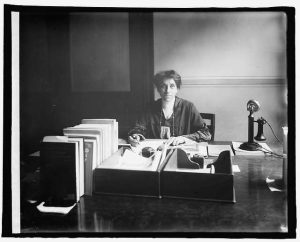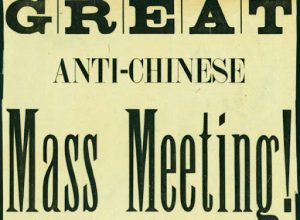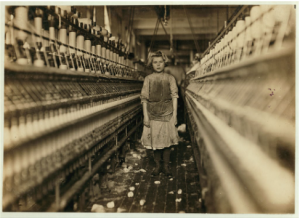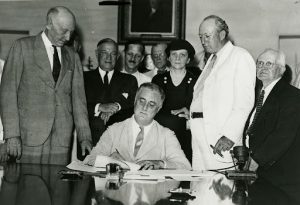5 The Progressive Era’s Response to Social Needs
Stephanie Saulnier
Section 5.1: Early 20th Century Reforms and Child Welfare
The time between 1900 and World War I is referred to as the Progressive Era. Although this time was generally prosperous there was a growing resentment towards the ultrarich and powerful and concern about societal problems impacting daily life, especially in the big cities. Reformers believed that problems such as disability, disease and poverty were the result of the social environment and could best be addressed through education, workplace and environmental safety and the involvement of a fair government.
Progressive women were prominent during this time and their organizations, and their advocacy, led to significant change, including the 19th Amendment, which granted women the right to vote. The Women’s Christian Temperance Union, established in the late 1800’s was focused on a range of issues including labor, child welfare, public health and suffrage.
Children were the focus of much of the reform during this period. The Children’s Bureau was established in 1912 and was the first federal agency in the world developed exclusively for the welfare of children (Warren & Kavanagh, 2023). The Bureau, originally led by Chicago social worker Julia Lathrop, began educating the public and legislators about the importance of maternity care and early childhood development. This work led to the first piece of federal funded legislation focused on maternal and child health, the Sheppard-Towner Maternity and Infancy Care Act of 1921. This legislation was discontinued after a couple years but paved the way for the inclusion of programs for women and children in the Social Security Act of 1935.

Figure 5.1: Miss Julia Lathrop
The Children’s Bureau published research about child development, particularly related to the impact of child labor. The National Consumers League (headed by Social Worker Florence Kelly) sought child labor laws and protectionist legislation for women. The US Supreme Court ruled that federal child labor laws were unconstitutional but states began developing legislation. Juvenile courts were established in some local jurisdictions so that the judges could explore their family situations and examine a range of options including probation.
Section 5.2: Immigration Policy
During the Progressive Era, immigration policy in the United States reflected a mix of reformist ideals and growing nativist sentiments. Concern grew as native-born Americans feared job competition and cultural and religious differences from the massive influx of immigrants from Italy, Poland, Russa, Asia and Mexico. These immigrants were more likely to be fleeing poverty, political oppression and religious persecution. The result was a focus on who was American and what it meant to be American.
The new immigrants were seen as suspect because they tended to settle in less ethnically diverse communities. They were accused of holding on to their languages, traditions and cultures instead of acculturating themselves as Americans. The Settlement House movement actively worked in ethnic communities to encourage new immigrants to learn English and the democratic process.
The Chinese Exclusion Act in 1882 was the first piece of targeted immigration legislation, banning Chinese laborers. This was followed by legislation aimed at controlling who was allowed to immigrate. From this point, the concept of Eugenics was closely tied to immigration law. Eugenics is the idea that society can be improved through selective breeding and by prohibiting certain people from procreating, you can improve the overall population. Immigration policy was seen as one way to limit the “watering down” or weakening the most admirable American traits. To proponents of this theory, the ideal American was Anglo-Saxon and had adapted to the culture, character and language of Anglo-America.

Figure 5.2: Single page, single-sided broadside by the Tacoma Anti-Chinese Committee
A list of the major U.S. Immigration Policies between 1790 and 2006 can be found on the Migration Policy website.
Section 5.3: Labor Laws
Despite the widespread understanding that workers, especially children, needed protection that business owners were unable or unwilling to provide, advocates during the Progressive Era were stymied in their attempts to get it from the federal government.
After a 1900 Census showed that almost 2 million children were working in dangerous environments including mills, fields, mines and factories, groups like the Women’s Christian Temperance Union supported a range of reforms that would ban child labor and protect women (The U.S. National Archives and Records Administration, 2022). The Keating-Owen Child Labor Act was passed in 1916 and banned the sale of products made by businesses that employed children under a certain age. This act, however, was overturned by the U.S. Supreme Court which believed it was an overreach of the government’s authority to regulate business. It was not until the 1938 Fair Labor Standards Act that there were federal limitations on the type and number of hours that children could work.

Figure 5.3: Little Spinner in Globe Cotton Mill
Little spinner in Globe Cotton Mill, Augusta, Ga. Overseer said she was regularly employed. Location: Augusta, Georgia. Photo by Lewis Wickes Hine,1909 January. https://hdl.loc.gov/loc.pnp/nclc.01641
The US Supreme Court did uphold a state law that limited the kinds and conditions of work for women. In the 1908 Mueller v Oregon case, the Court found, “the physical well-being of women becomes an object of public interest and care in order to preserve the strength and vigor of the race (Muller v Oregon, 1908).” Despite there being little support for protections for children in the early part of the nineteenth century, in the case of women, it was believed that the role of mother was so important, that governmental intervention was warranted. Additionally, in the case the Court asserted that women had always been dependent on men and therefore should be awarded additional protections (Gannon, 2025).
For men, cash benefits and medical for federal government employees injured on the job while doing hazardous work was one of the first forms of social insurance in 1908 (Social Security Administration, 2017). There was little support for federal laws covering all workers but by 1920, most states had established workmen’s compensation laws. Employers used a variety of legal defenses to place part or all of the responsibility for work-related injuries on employees but the development of a statewide insurance pool allowed benefits determined on the basis of the specific type of injuries for workers who were injured on the job (Guyton, 1999).
Section 5.4: Health Reform during the Progressive Era
Turn-of-the-20th-century Americans increasingly believed that environmental factors thwarted the healthy development of city dwellers. Reformers countered the Social Darwinists’ argument that life should be devoted to competition. Many reformers also contended that unregulated economic activity would create unacceptable levels of social distress. Research began to show an irrefutable correlation between the physical conditions in the cities and at work and poor outcomes. There were concerns that unregulated capitalism may not lead to economic prosperity for all.
During this time period, as many as 20 percent of the populations of entire cities were killed by such epidemics as cholera, typhoid fever, and malaria. Children died in great numbers from influenza, whooping cough, measles, and scarlet fever. Public health Reforms included centers in many American communities where residents received newly developed inoculation and public health inspectors enforced regulations that required sanitary conditions in housing, restaurants, and other businesses.
This was an example of collective solutions for social problems. We recognized that epidemics and unsanitary conditions were affecting all people and could not be solved by one group. There was a growing concern that no matter how careful and isolated you thought you were, you could still be impacted by the disease and peril around.
The Progressive Era also saw the introduction of an initial set of aftercare services for people who had been institutionalized in mental asylums. The work of Clifford Beers, himself a former mental patient who had written about his ordeal in public institutions, led to the establishment of non government societies for mental hygiene. The Progressive Era saw the introduction of an initial set of aftercare services for people who had been institutionalized in mental asylums. Established National Committee for Mental Hygiene.
A capitalistic medical care model developed during this time period and followed two-tracks. In the first, physicians and nongovernmental hospitals were funded by fees charged to patients. In the second, the poor who could not afford the fees, either went untreated or sought care from public hospitals which were underfunded and poorly staffed. This is the beginning of the US health care system and the inequity of services. You get what you can afford. This is an example of a lost opportunity in America based on the hard work and individualist values of our country.
Section 5.5: The Social Security Act: Laying the Groundwork for Modern Welfare
The opulence and laissez faire capitalism of the 1920s ended abruptly in the bottom falling out of the stock market in October of 1929. The crash led to bankruptcies, tightening of credit and mortgages and bank failures. This, combined with a drought in the west and Midwest, ushered in the Great Depression. The American belief that hard work and living a moral life led to prosperity was challenged as a quarter of the labor force was unemployed. Properties, especially farms, were lost as people were unable to keep up with mortgage payments.
President Herbert Hoover’s actions reflected the American belief that the federal government had very little authority to intervene in economic matters and that recovery and relief should come from the local and state level. This approach, however, was unsuccessful due to the sheer level of need. In 1933, Franklin D. Roosevelt was elected President, and he developed a two pronged attack – first, there needed to be swift and comprehensive federal action to address the current crisis. Second, he felt that there must be regulations and processes in place to ensure that an economic disaster of this magnitude could not ever occur again. Congress and FDR’s administration established the New Deal, a wide-ranging package including programs to address the “3 Rs – relief for the unemployed, recovery of the economy and reform of the financial system” (Berkin et al., 2011).
The Social Security Act of 1935 established various public assistance and social insurance programs, including old-age pensions and unemployment insurance, as well as aid for children and mothers. Despite immediate challenges in the Supreme Court, the Social Security Act marked the real beginning of the federal government’s responsibility for the general health and welfare of all citizens. Since 1935, the Social Security Act has been expanded to cover spouses and children of the working population, people with disabilities and to provide healthcare for people in poverty.

Figure 5.4: President Franklin D. Roosevelt signs the Social Security Act
References
Berkin, C., Miller, C, Chemy, R., & Gomly, J. (2011). Making America: a history of the United States, Vol. 2: from 1865. Cengage.
Gannon, P. (2025). Labor and labor: the sexism and legacy of Muller v Oregon. The Georgetown Journal of Gender and the Law 26(2). https://www.law.georgetown.edu/gender-journal/online/volume-xxvi-online/labor-and-labor-the-sexism-and-legacy-of-muller-v-oregon/
Guyton G. P. (1999). A brief history of workers’ compensation. The Iowa Orthopaedic Journal, 19, 106–110. https://pmc.ncbi.nlm.nih.gov/articles/PMC1888620/
Johnson, F. R. (1911). The Board of Public Welfare of Kansas City. The Survey, 1363-1365. https://socialwelfare.library.vcu.edu/public-welfare/functions-and-services-of-the-kansas-city-board-of-public-welfare-1910-1911/
Lissac, R. S., (1989). Pluralism and Progressives: Hull House and the New Immigrants, 1890-1919. University of Chicago Press.
Marinari, M. (2022). The 1921 and 1924 Immigration Acts a century later: roots and long shadows. Journal of American History, 109(2), 271-283.
Muller v. Oregon, 208 U.S. 412 (1908). https://supreme.justia.com/cases/federal/us/208/412/#:~:text=Oregon%2C%20208%20U.S.%20412%20(1908)&text=Since%20the%20state%20has%20a,from%20restricting%20their%20working%20hours.&text=Oregon%20imposed%20a%20law%20that,of%20longer%20than%2010%20hours.
PHILO-notes (2022, May 17). What is elitism? YouTube. https://youtu.be/4_hlx3n0fl0?si=O1i0A97rBEy24i5fThe U.S. National Archives and Records Administration. (2022). Keating-Owens Child Labor Act. Milestone Documents. https://www.archives.gov/milestone-documents/keating-owen-child-labor-act.
Warren, M.D. & Kavanagh, L.D. (2023). Over a century of leadership for maternal and child health in the United States: an updated history of the Maternal and Child Health Bureau. Maternal and Child Health Journal. https://doi.org/10.1007/s10995-023-03629-0.
